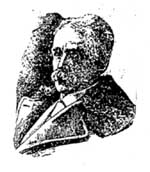
READ CHAPTER 1
GALLERY
WHO'S WHO
ATLAS
MYTHS DEBUNKED
FAMILY TREE
CONTACT THE AUTHOR
UPCOMING EVENTS
REVIEWS
CHICAGO HISTORY LINKS
READING SUGGESTIONS
BUY THIS BOOK
Julian Hawthorne

Born: June 22, 1846.
1873-1896: Publishes 26 novels: Bressant, Idolatry, Garth, Sebastian
Strome, Achibald Malmaison, Dust, Fortune's Fool, Beatrix Randolph, Love
Read Hawthorne's account about the English fad of palmistry.
In my childhood I was surrounded by grown-up persons, but it never occurred to me that I would ever be like them. Later, when I discovered that time bears some relation to age, I parried the blow by thinking that I would be taken out of the maze while still in the bloom of my youth After that I had a persuasion that I would at any rate die early, and at last I fixed the precise date as the month of April, in the year 1897, and that I was be drowned at sea. But when the time arrived I was in Jubbulpore, in the midst of the Punjaub (sic), where there was not even water enough, fresh or salt, to take a bath in. But by this time I was past fifty years of age, and people of fifty, in my young days, were called old. I now perceived, however, that human age ought not to be confounded with mere lapse of years. I felt that I was still young within, and that to consider myself old would be to submit to a popular delusion.
from Shapes That Pass: Memories of Old Days by Julian Hawthorne (Boston and New York: Houghton Mifflin Company, 1928).
The trouble with Chicago is, not that it is not central enough, but that it is too central. From whatever point on the plane you start it takes forever to get here. And on all sides there is that interminable stretch of flat and doleful country to be got over before you arrive Chicago people admire the changing colors of their lake. The color does change often, but after watching the variations for a couple of months, I have only twice or thrice seen a good color. I prefer the hues of the ocean.
from Humors of the Fair by Julian Hawthorne (Chicago: E.A. Weeks & Company, 1893).
In the book Hawthorne's Son: The Life and Literary Career of Julian Hawthorne (Columbus: Ohio State University Press, 1970), Maurice Bassan offers this assessment of Hawthorne's literary work:
The literary reputation of Nathaniel Hawthorne's only son, Julian, led some critics in his own day to compare him favorably with George Eliot, Henry James, and William Dean Howells, as well as his father. This was a mistake, but time has repaired it indeed, has savagely reversed the scales.
Julian, the young pretender to the glorious family name, certainly outwrote his somewhat slugglish father quantitatively; he was the author of no less than twenty-six long and short novels, over sixty short stories, almost a hundred essays, and several lengthy works of biography and autobiography. Yet who today remembers a single one of his books unless it be the still well-regarded Nathaniel Hawthorne and His Wife, the reverential biography? The primary reason for Julian Hawthorne's decline ought to be stated frankly at the outset: in an age of giants like Clemens and James to speak only of his American contemporaries Hawthorne was a pygmy. He was a fascinating but shallow man, and his works reflect more of the shallowness than of the fascination. "No good novel," James wisely remarks, "will ever proceed from a superficial mind." Yet, surprisingly, there are quite genuine if rare treasures scattered here and there in the works of the younger Hawthorne, treasures that ought to be recovered unapologetically.